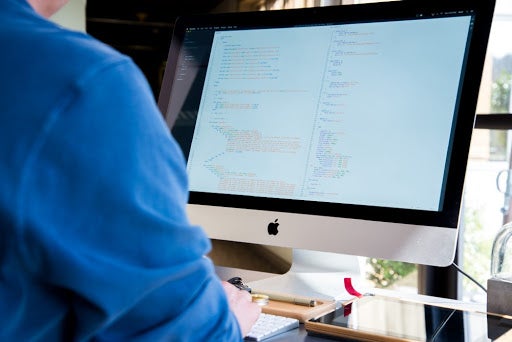Contents
- What is Deep Work?
- Why is Deep Work Important?
- Real Examples of Deep Work
- 4 Tips and Reminders for Deep Work
Do you struggle with how to make productivity improvements on your virtual team? Do you know how to ensure teammates aren’t distracted? Do you know how to guarantee tasks get delivered on time?
We have the answer: Deep Work.
In a survey of 450 remote workers, TalentLMS found that 90% of survey respondents get more work done when working remotely.
Deep Work is critical for productivity improvements when managing any team, but it is fundamental for remote workers. We know from experience that there’s a strong correlation between Deep Work and the business value delivered. And, this applies to all industries — not just software development — because it relates to how we work.
In this post, we’ll define Deep Work, show a few examples of how it’s used in our business today, and provide 4 best practices for getting started with Deep Work in your company.
What is Deep Work?
Today we are surrounded by endless distractions. How many times have you looked at your phone, read social media or checked your email today? These distractions lead to splitting up attention and cutting into your productivity.
Deep Work is a concept coined by Cal Newport in his book called Deep Work: Rules for Focused Success in a Distracted World. Newport, a Computer Science professor at Georgetown University, explains that succumbing to these constant distractions compromises our ability to focus on activities of cognitive worth. Instead of working in lengthy time blocks of frequently interrupted, “shallow” work, you can ensure that productivity and quality are maximized by spending shorter 2–3hr blocks of time dedicated to a single task.
To engage in Deep Work, Newport suggests developing a calendar to log your activities so you can see how much time you spend on each task. If you are still having trouble working in longer blocks of time, consider changing your work environment. When J. K. Rowling found herself struggling to complete the final book in her Harry Potter series, she booked a suite at the five-star Balmoral Hotel in Edinburgh and stayed there until her book was finished.
Why is Deep Work Important?
There are two reasons you should care about Deep Work. As Mara Schmid wrote in her book review, there are “two core abilities for thriving in the new economy: 1) the ability to quickly master hard things; 2) the ability to produce at an elite level, in terms of both quality and speed”. The answer to cultivating both abilities: Deep Work.
At Crossover, we believe Deep Work is one of the most important abilities to master. Deep work leads to productivity. In contrast, Shallow Work is non-cognitively demanding, easier to replicate, and often done with distractions. Many of our partners who embrace Deep Work say they can get all their daily activities done within an eight-hour workday, giving them the freedom to do other things like enjoying family time. One of our managers was able to use Deep Work coaching to increase their team’s quality by 15% and productivity by 20% in four weeks.
Real Examples of Deep Work

Photo by Lee Campbell on Unsplash
The two core insights we use for evaluating Deep Work are Intensity Score and Focus Score data. The Intensity score assesses the individual’s ability to focus on one activity at a time rather than frequently switching from one activity to another. Focus score appraises the keyboard strokes and mouse clicks to determine the intensity of work. These scores help our partners to self-evaluate their productivity levels and alignment to the team goals.
At Crossover, managers leverage three indicators to manage their teams: Deep Work (measured by the scores highlighted above), productivity (reported by our tool WorkSmart), and work habits (studied through a methodology called Gemba Walks).
We did not invent Gemba walks. We adapted it to the remote work context from one of the most successful manufacturing companies in the world: Toyota. Taiichi Ohno, an executive at Toyota, led the development of the Gemba Walk. Toyota uses this methodology to detect gaps that need to be addressed and use them to build processes for improvement.
At Toyota, Gemba walks look like managers getting up from behind their desks and walking along the factory floor. At Crossover, Gemba Walks refer to observing what your team members are doing by looking at their screenshots, applications, and focus data. WorkSmart has a dedicated tool to allow you to view team members screens quickly. Our managers use the Gemba Walk to find the blocks of time wasted using the wrong tools, or doing tasks in the wrong order. Managers use these insights from Worksmart to craft a corrective plan and provide coaching during daily Check-in Chats.
Here are some real examples of how it is used.
Thomas Juhasz uses the Gemba Walk in Worksmart to analyze the work behavior of one of his reports. At 11:44 am, Thomas sees that she is working on a software application that she is responsible for with good focus and intensity. Then at 12:54 pm, she is interrupted by one of her colleagues on Skype, a collaborative chat application. After a back-and-forth on Skype, she loses 10 minutes. Then she gets pulled into a Zoom meeting, a web conferencing application, and she loses another half hour. She then takes on another task that isn’t her responsibility, losing another two hours. Then she resumes her primary task. When Thomas asks her during a Check-in Chat what she was doing during those hours shes thinks the distractions added up to only minutes when it actually took hours. The coaching insight was that even though she has good intentions and wants to help other teams, it steals hours of her productive time for her primary responsibilities. Thomas would advise her to focus on the primary task and get rid of needless distractions. This will allow her to accomplish her tasks faster, and with higher quality.
In another great example, Thomas reads a product release log and notices a comment from one of his subordinates. However, this product release isn’t one of the partner’s responsibilities. Thomas asks him about this during the daily Check-in chat, also showing him the Gemba Walk he did. Thomas shows him that 1:48 pm he started the release process and finished at 2:56 pm spending 1:10 minutes doing this task. Initially, the worker said it wasn’t taking up too much time, but when the manager showed him the Gemba Walk, he was shocked. In this case, the Gemba Walk revealed that a partner deviated from his own responsibilities to act as a “crutch” for another team. By correcting this, the manager ensures that the person can focus on their own tasks using Deep Work, while the team that should have been responsible for the task wholly owns it.
In our final example, a Crossover partner was working on front-end tickets, which wasn’t his core competency because he came from a different coding background. Thomas does a Gemba Walk, revealing that he is using the wrong tool for the task. Having over ten years’ experience in this type of coding, Thomas suggests using a much better tool for the purpose. He also gives his direct report a whitepaper that he wrote on the best tools to use and the proper debugging methodology.
These are examples of using Worksmart Pro to detect patterns in time blocks and application usage to enable higher productivity. But you don’t need to use Worksmart; there are other time tracking tools like Timedoctor that you can use to evaluate time. By showing partners the same data, managers can demonstrate where time is wasted to get buy-in. Both managers and individual contributors want the same thing: better productivity. So, the sooner we can detect gaps, the earlier make corrective action.
4 Tips and Reminders for Deep Work
Here are some tips from Cal Newport for implementing Deep Work.
- Plan your Deep Work — Identify a dedicated workspace where you won’t be distracted. Pick an isolated place in your home. If you are working outside your home, find places where you won’t be distracted by loud noises or talking. Also, think about your day and figure out when you can dedicate long blocks of time to your work. Breaks are also necessary, so consider them in your schedule.
- Take breaks from focus — Just as it’s essential not to be distracted during long blocks of work, it is vital to give yourself scheduled breaks. Newport suggests scheduling “internet blocks” throughout your day where you’re allowed to use the internet. The time outside the blocks is kept free from internet use.
- Quit social media — Social media is one of the most significant time wasters. We don’t think a glance at your Facebook page takes much time, but as we heard in the previous real examples, they add up and steal from your productivity.
- Get rid of the shallow — It’s essential to take stock of your tasks and divide them into Deep and Shallow work. Get rid of as many Shallow tasks as possible. As I said before, Shallow work is done with distractions and doesn’t require much cognitive attention. Doing this type of multi-tasking work wastes lots of time.
Of course, everyone should want to experience the benefits of Deep Work, but it requires discipline and planning. For organizations with a remote workforce, Deep Work is critical for making productivity improvements. But everyone is positively affected by Deep Work. If you think about it, the pros outweigh the cons. Just think about what you will do with all your extra time.
For more business strategies for remote work check out our blog or better yet join us.
Credits: Ian Giles







